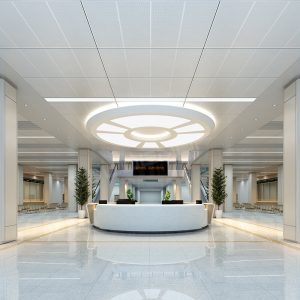Transforming an existing facility (or designing a new facility that emphasizes patient satisfaction and accommodation) requires some thoughtful design principles. There are a few key components that go a long way towards bettering the patient experience. These include:

Personal Touches. While many facilities are enhancing the patient’s wait time using check-in kiosks and computers; many patients still rely on human resources. Some patients are hesitant to rely on electronic systems, or they don’t know how to use them in healthcare facilities so at least one staff member should be stationed at the reception area to direct patients and answer questions.
Wayfinding. Reception and check-in desks should be easy to find and inviting. Custom-designed reception desks, contrasting finishes, and changes in color can all be used to help direct patients through the facility.
Comfort. A more comfortable reception and waiting area means a happier patient. Also, maintaining an appropriate indoor temperature is another factor for comfort which requires the strategic location of air registers in ceilings. Chairs that are comfortable help reduce stress and when combined with soothing colors and art on the wall make the waiting experience better.
Privacy. A patient’s health is a sensitive and confidential topic. Patients may also have anxiety about their visit to a healthcare facility. By positioning waiting room/seating areas away from the often busy reception area, it gives patients more privacy to feel relaxed before their appointment. This also helps protect patient information since receptionists are often handling confidential information.
Future Forecasting. Healthcare reception design will continue to integrate technology at a greater level so it’s important to anticipate future shifts when designing the reception area. This will mitigate disruption to the clinic as new technology is introduced to the facility.
